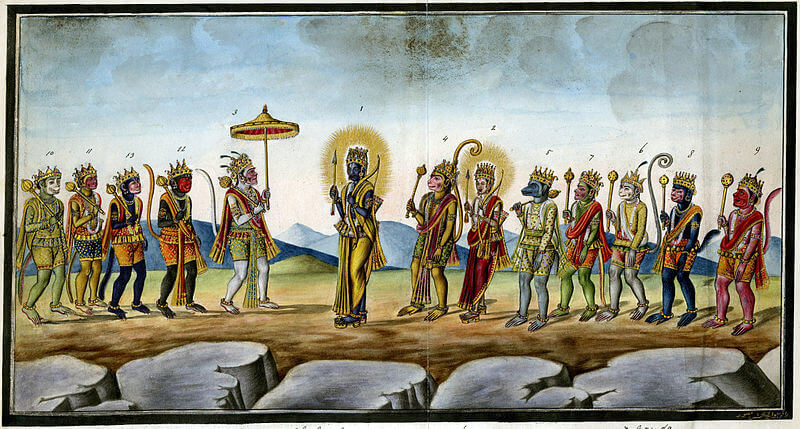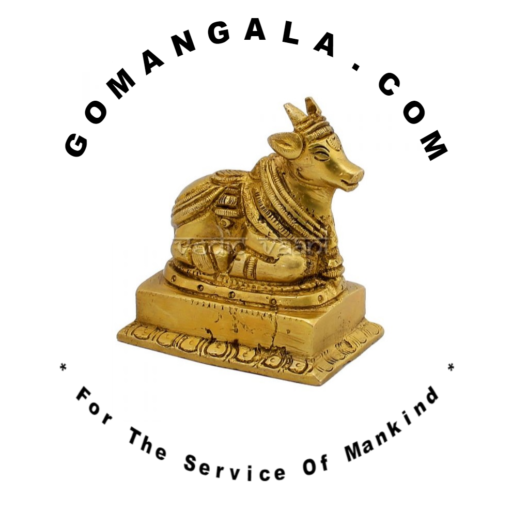Rama and Lakshmana moved towards the stream Pampa and they had seen the Mountain Rishyamukha. Hanuman greeted them and introduced to Sugriva and then Rama and Sugriva entered into a treaty to be friends and help mutually. Rama killed Vali and then told Sugriva to coronate Angada as the prince of Kishkindha. Then Angada was crowned as the prince of that country, of monkeys, and crowned Sugriva as the King of Kishkindha. However, Hanuman had requested Rama to come into the Kishkindha Palace, for gracing the occasion of coronation of Angada as prince. Rama thought and told him, about his vow, not to enter any village, town or city, as to keep up his promise, done before his father, but to spend fourteen years in the forest, avoiding entry into any village or city.

चतुर्दश समाः सौम्य ग्रामं वा यदि वा पुरम् । न प्रवेक्ष्यामि हनुमान् पितुर्निर्देश पालकः ॥
The meaning: In order to keep my promise with my father, I should complete the fourteen years in exile, I shall not enter any village or city. It may be treated softly.
Hence, temporarily at Prasravana Mountain, they waited for the report of Sugriva. Later, for nearly three months, seasonal rains had caused them delay in searching operation for Sita. Sugriva had made five batches with five war brigadiers. He had sent four of them to four different directions, by providing each with sufficient details of respective places to search for Sita. The fifth one was entrusted to search the nearby area of Kishkindha and to protect own country. There could not be any place on earth about which Sugriva did not know. Except caves, he had seen all places when Vali had chased him. He took benefit of that incident.
The administration of Sugriva was efficient and appreciable. The order of Sugriva could not be ignored, or better say, could not be thought of delay, by anybody. In the search troop sent to the southern direction, there were efficient vanaras like Hanuman, Jambava, Angada and his mother Tara, with some other able ones too. They thoroughly searched all the villages, towns, forests and caves and moved to south from the Mountain Vindhya. Sugriva had already given instructions to them, about the countries ruled by Pandyas to the east of Mathanga Mountains, and about the islands to the western side, in the middle of oceans. One day, they reached at noon to an area full of trees but without source of water. They were thirsty and hungry but no food or fruits were found by them.
Finally, in the level meadows, they found some soil humps with one cave. Some ducks and swans were exiting, out from the mouth of that cave. Also, few lions had come out of the cave, with their paws covered in mud, dripping water. Hanuman guessed about water inside the cave which was urgently needed for them for drinking.
First, Hanuman entered the cave, with his mace in the right hand and his left hand stretched. Jambava stretched his left hand and held with his right hand, the left hand of Hanuman. Angada stretched his left hand and held with his right hand, the left hand of Jambava. Tara stretched her left hand and held with her right hand, the left hand of Angada. Similarly, another monkey stretched his left hand and held with his right hand, the left hand of Angada. Thus, making a chain, they continued and moved into the cave cautiously. When all of them entered, they assembled breaking the chain and making a circle inside the cave and wondered to see a shining palace, full of gardens and trees, like a big city there.
They hoped to get water, but they saw an old lady in a hermit at a distance looking at them. Hanuman requested for water and told her regarding their feat, but she understood the requirement of food at noon and arranged for their meals immediately. After having food, Hanuman again explained, the entire story in brief to her and requested for help. They enquired about the strange city there and about the various wonderful shining palaces. The old lady told them her name as Swayamprabha and she was the friend of Hema. Hema was the mother of Mandodari, and wife of Mayasura, the famous architect. Hema was an Apsara, expert in singing and dancing and she was the mother-in-law of the demon Ravana.
मम प्रिय सखी हेमा नृत्त गीत विशारदा । तया दत्त वरा चास्मि रक्षामि भवनं महत् ॥
The meaning of the above verse as in the Valmiki Ramayana: Hema was her friend, who was an expert in singing and dancing, she had appointed Swayamprabha as the protector of those marvelous palace buildings. Hence she was protecting them.
Hanuman and the troop got good food and then they searched for Sita there, but confirmed Sita was not there. They could enjoy the beauty of the premises and gorgeous buildings which were built by Mayasura for Hema.
कांचनानि विमानानि राजतानि तथैव च । तपनीय गवाक्षाणि मुक्ता जलावृतानि च ॥
The meaning: The buildings were mounted with golden peaks and the windows were covered with silver linings, the lakes were full of water and pearls beads. There were aeroplanes also. The architect Mayasura was manufacturing the required parts in Mahendra Mountain and used to assemble in this city. Vimana have double meaning, peak of the roof and also as aeroplane. But Hanuman and the troop had no time to look and enjoy the beauty of that city of Hema and hence were in a hurry to get out of the cave. Hence, they enquired the way to get out of that wonderful city with Swayamprabha. But they got an awful reply as no body till that date had escaped out of that place nor returned once they entered into that cave.
Hanuman calculated her as a good lady, and had spoken with reverence to Rama. Then she felt happy and said to them, as they were obedient to follow Dharma, for such actions, she would have no duty to be an obstacle on their way. She requested them to close their eyes and she would guide them out and to keep the exit door of the cave as a secret. All of them followed and came out of the cave, and proceeded towards the southern direction, searching for Sita.
The troops then moved appreciating the capabilities of Mayasura. They had seen a wide level ground and it was a good city and thanked Swayamprabha for her treatments. Hanuman had felt that luxury could not help them then.
After receiving the gift of Pushpaka Vimana, Mandodari with Ravana desired to visit Mount Kailasha and to worship God Shiva where Hema had done her penance. It was their first tour in Pushpaka Vimana but the Pushpaka Vimana was the second one in its series. Mayasura had already offered the first Pushpaka Vimana to God Shiva which was kept in the custody of Kubera. Ravana and Mandodari travelled in their own vehicle from Lanka to Mount Kailasha and during the landing before God Shiva, the horns of Nandi touched the Pushpaka Vimana, and the body of the aero plane fully crashed. Since the place was ruled by God Shiva himself, nothing wrong happened to the couple. Abandoning the damaged vehicle, they worshipped God Shiva and they prayed for better prospectus of their country and family for a long time.
Then they thought of the return journey and found the first Pushpaka Vimana with Kubera, the angel of wealth. Kubera had seen the anklet of Mandodari and thought; her anklets should not touch the ground. Then he thought it would be better for himself to get a better vehicle than his aero plane and requested to arrange with God Shiva to rearrange. God Shiva called God Vishnu. Vishnu had passed the decree. Kubera would hand over his Pushpaka Vimana to Mandodari. As Kubera had to procure huge quantities of heavy gold, frequently from various places to Mount Kailasa, and that required a strong and able vehicle, but an aero plane could not accomplish such task. Hence Vishnu himself allotted his Gajalakshmi to Kubera for the service of God Shiva. Then Kubera, the angel of wealth also, benefitted by Gajalakshmi. All agreed.
Ravana and Mandodari travelled in that vehicle, the Pushpaka Vimana got from Kubera, from Mount Kailasha and during the returning, landed at the Palace of Hema. Mandodari showed her gratitude to her mother, Hema. Swayamprabha had decorated the Pushpaka Vimana, and the body of the aero plane was fully shining then. Thereafter, they used that vehicle as their own one.
Hanuman with his searching troop, reached the beach at Dhanushkodi. As per the advice of Jambava, Hanuman had stepped a few feet back, on to the mountain to pick up the speed, sufficient to jump over the sea, to reach Lanka.
Mayasura had written a book on architecture and it is available as Mayamatam which is in Sanskrit. The styles of Sanskrit verses are easy to grasp, like the verse, as below, regarding the idol of Sasta, written by Mayasura in his Mayamatam book:
मोहिनी तनयः शास्ता द्विभुजः श्याम सन्निभः । पी ठस्थः कुंचितांघ्रि स्व वाम पादं प्रलपितान् ॥
The meaning: Sasta is the son of Mohini, Vishnu in disguise, in the form of a beautiful lady. Sasta has two strong shoulders, black in color, sitting on his own feet on the circular seat, left hand stretched. His right hand shows symbol of Advaitha principle.
The book Mayamatam is a proof of ancient Indian Architecture which got translated to English and many other languages.
It is humbly prayed for the blessings of God Rama upon us.
Next post, being of Mainda and Dwividha in Ramayana, may not be missed. Dreams and Reality in Ramayana would be presented separately in another article.
Readers may provide feedback and share this story with friends and family.

Hari Bol 🙏